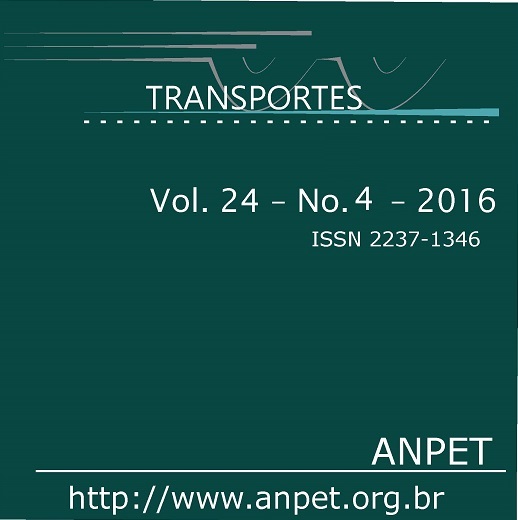Metodologia para planejamento de um de sistema cicloviário
DOI:
https://doi.org/10.14295/transportes.v24i4.1158Keywords:
Bike lanes, indicators, evaluation.Abstract
This paper presents a methodology for planning a bikeway system, for supporting the municipality in the imple-mentation of these systems in order to promote the use of bicycles, especially, as an alternative way of daily transport to work and to study. The proposed methodology set out analyzing parameters that are used in methods for assessing cycle lanes. After this review, a survey was conducted to the cyclists in order to identify their usual routes and which the most important parameters in choosing a route from its origin to its destination in daily commute. Therefore, the association of these two researches gave the support to define indicators for assessing road segments for the calculation of an index defined as Index of Adequacy of the Segment for travelling by bicycle. This index allows defining which segments of a road network are suited to be part of a bikeway system.Downloads
References
AASHTO, (1999). Guide for the Development of Bicycle Facilities. Washington, DC, USA
CROW.(2011) “Manual de Diseño Para El Tráfico de Bicicletas”. Ploeger.J & Kroeze. P.A. Holanda.
DENATRAN. (2001) Manual de procedimentos para o tratamento de pólos geradores de tráfego. Brasília: DENATRAN/FGV,
FHWA (1998) BCI. The Bicycle Compatibility Index: A Level of Service Concept, Implementation Manual. FHWA-RD-98-095, Federal Highway Administration, Washington, DC.
Davis, J. (1987) Bicycle Safety Evaluation. Auburn University, City of Chattanooga, and Chattanooga- Hamilton County Regional Planning Commission, Chattanooga, TN.
Dixon, L. B.(1996) Bicycle and Pedestrian Level-of-Service Performance Measures and Standards for Congestion Management Systems. Transportation Research Record n.1538, p. 1- 9,.
Eastman J.R. E Jiang, H. ,(1996) “Fuzzy Measures in Multicriteria Evaluation. In: Proceedings, Second International Symposium on Spatial accuracy Assessments in Natural resources Environmental Studies”,. Fort Collins, Colorado. p.527-534.
Eddy, N. (1996) Developing a Level of Service for Bicycle Use. Pro Bike/Pro Walk 96 Resource Book. Proceedings of the Ninth International Conference on Bicycle and Pedestrian Programs Resource Book, Bicycle Federation of America and Pedestrian. Federation of America, pp. 310-314.
Ehgott, M. et al (2012). A bi-objective cyclist route choice model. Transportation Research Record, No. 46 Part A , Transportation Research Board, Washington, DC.
Epperson, B. (1994). Evaluating suitability of roadways for bicycle use: toward a cycling level of service standard. Transportation Research Record 1438, 9-16.
GEIPOT – Empresa Brasileira de Planejamento de Transportes. (2001) Planejamento Cicloviário: Observação Nacional. Brasília. 2001.
E. Heinen, B. van Wee, K. Maat Commuting by bicycle, an overview of literature. Transport Reviews, 30 (2010), pp. 59 pp
Landis, B. W.; Vattikuti, V. R.; Brannick, M. T.(1997) Real-time human perceptions: toward a bicycle level of service. Transportation Research Record 1578, 119-126.
Monteiro, F.B. (2011)Avaliação de espaços urbanos para pedestres e ciclistas visando a integração com o transporte de massa. Dissertação de Mestrado. Instituto Militar de Engenharia. Rio de Janeiro, Brasil.
Cardoso, P.B. (2014) Metodologia para implntação de sistemas Cicloviários. Dissertação no Programa de Mestrado em Engenharia de Transportes do Instituto Militar de Engenharia. Rio de Janeiro
RICHARDSON, R. J. ( 1999) , Pesquisa Social – Métodos e Técnicas. 3a ed. São Paulo: Atlas.
Shaffer, H. B., R. N. Fisher, and C. Davidson.n(1998) The role of natural history collections in documenting species declines. Trends in Ecology and Evolution 13:27–30.
Sorton, Alex; Walsh, Thomas (1994). Bicycle Stress Level as a Tool to Evaluate Urban and Suburban Bicycle Compatibility. Transportation Research Record 1438. TRB, National Research Council, Washington, DC, pp. 17-24.
TRB. Highway Capacity Manual. (2000) Transportation Research Board, National Research Council, Washington, D.C., EUA.
Vandenbulcke, G.; Thomas, I. Geus, De B.; Degraeuwe, B.; Torfs, R.; Meeusen, R. e Panis, L.I. (2009) Mapping bicycle use and the risk of accidents for commuters who cycle to workin Belgium. Transport Policy, No.16, 77-87, Washington, DC.
Downloads
Published
How to Cite
Issue
Section
License
Authors who submit papers for publication by TRANSPORTES agree to the following terms:
- The authors retain the copyright and grant Transportes the right of first publication of the manuscript, without any financial charge, and waive any other remuneration for its publication by ANPET.
- Upon publication by Transportes, the manuscript is automatically licensed under the Creative Commons License CC BY 4.0 license. This license permits the work to be shared with proper attribution to the authors and its original publication in this journal.
- Authors are authorized to enter into additional separate contracts for the non-exclusive distribution of the version of the manuscript published in this journal (e.g., publishing in an institutional repository or as a book chapter), with recognition of the initial publication in this journal, provided that such a contract does not imply an endorsement of the content of the manuscript or the new medium by ANPET.
- Authors are permitted and encouraged to publish and distribute their work online (e.g., in institutional repositories or on their personal websites) after the editorial process is complete. As Transportes provides open access to all published issues, authors are encouraged to use links to the DOI of their article in these cases.
- Authors guarantee that they have obtained the necessary authorization from their employers for the transfer of rights under this agreement, if these employers hold any copyright over the manuscript. Additionally, authors assume all responsibility for any copyright infringements by these employers, releasing ANPET and Transportes from any responsibility in this regard.
- Authors assume full responsibility for the content of the manuscript, including the necessary and appropriate authorizations for the disclosure of collected data and obtained results, releasing ANPET and Transportes from any responsibility in this regard.










